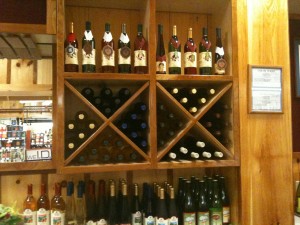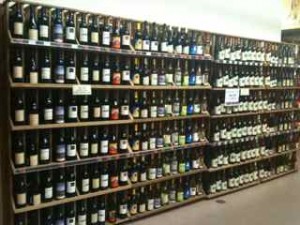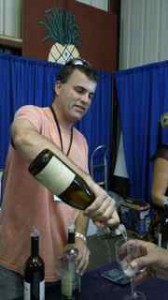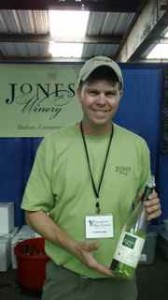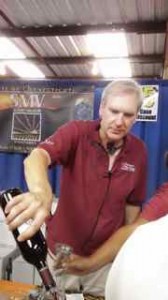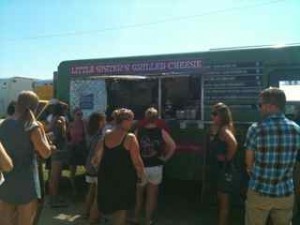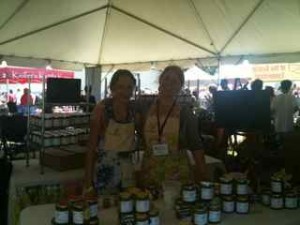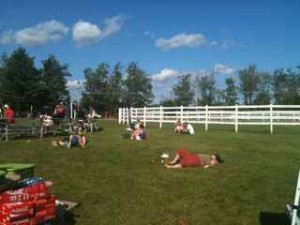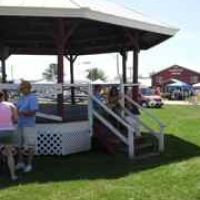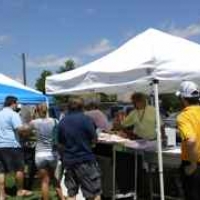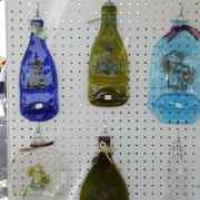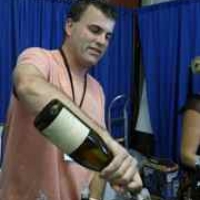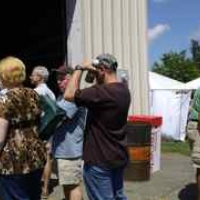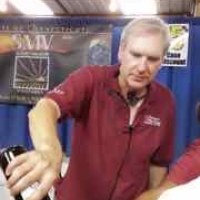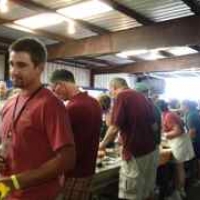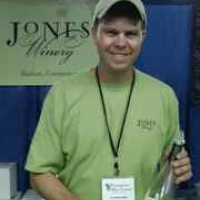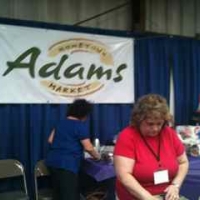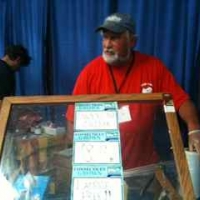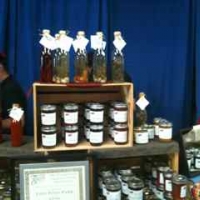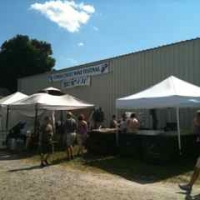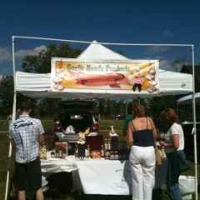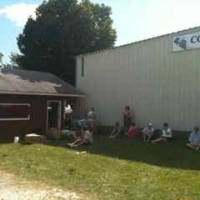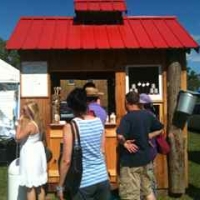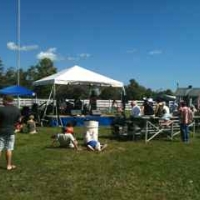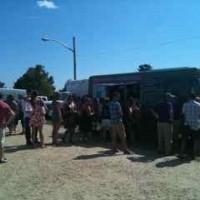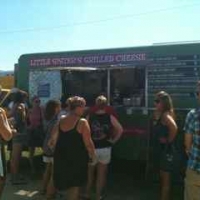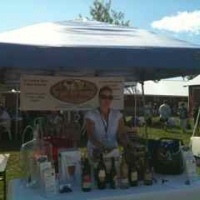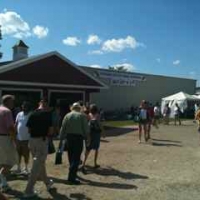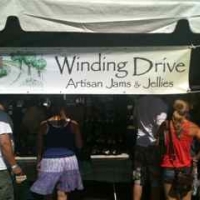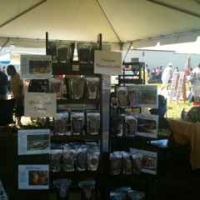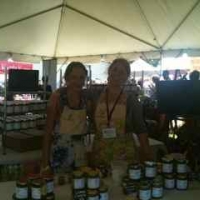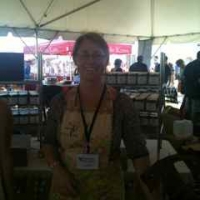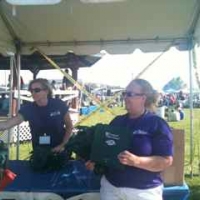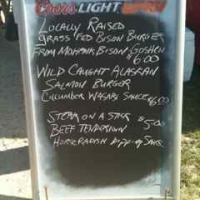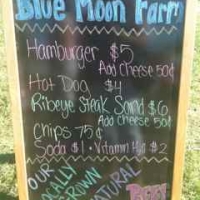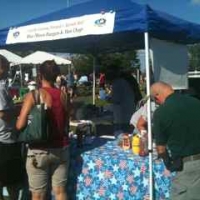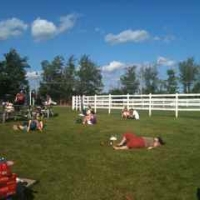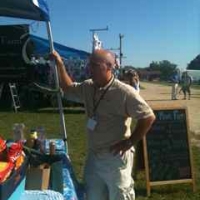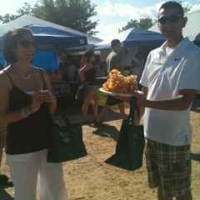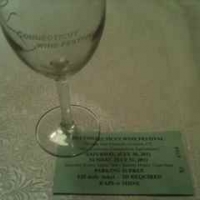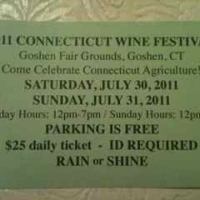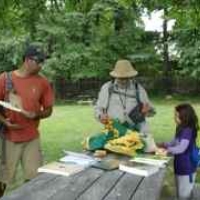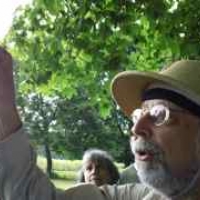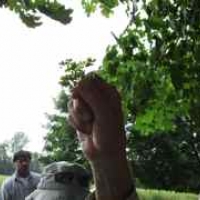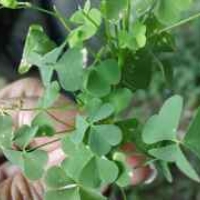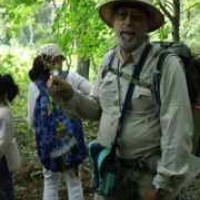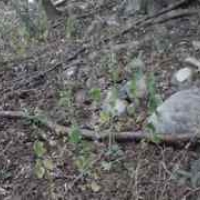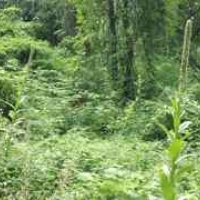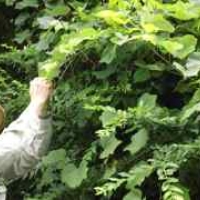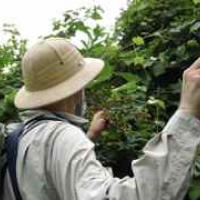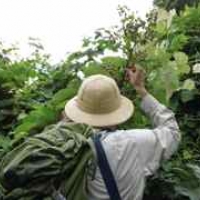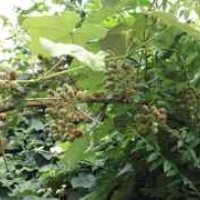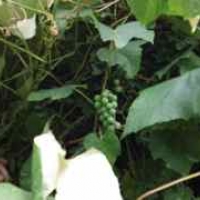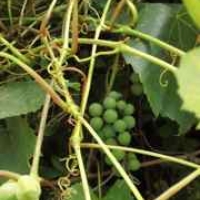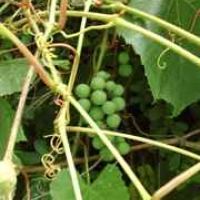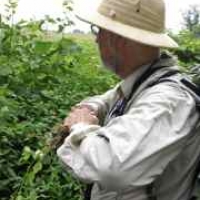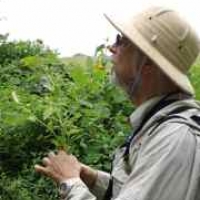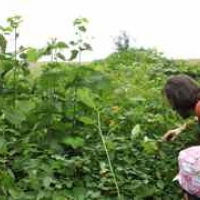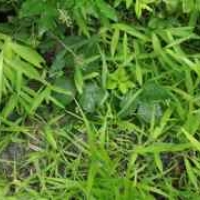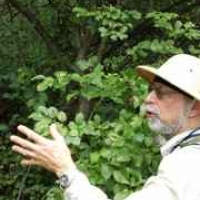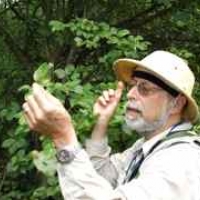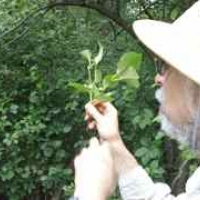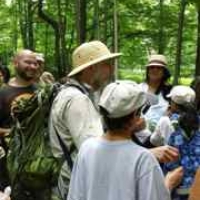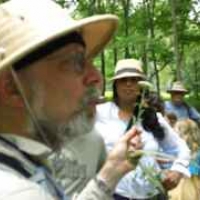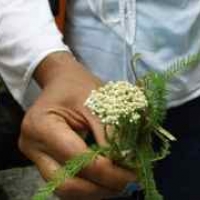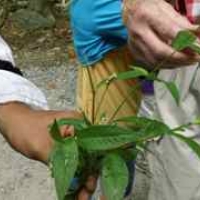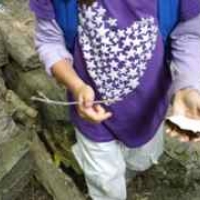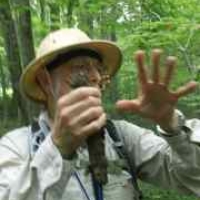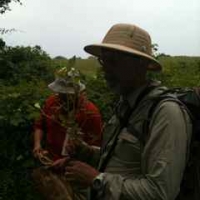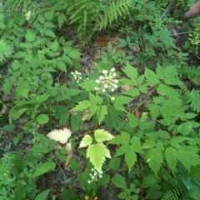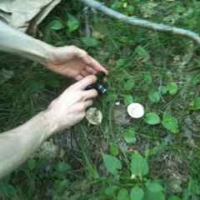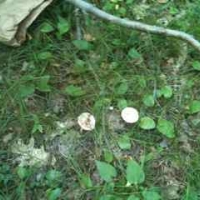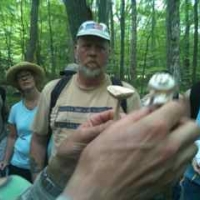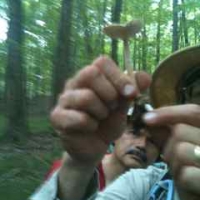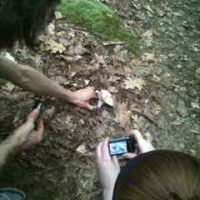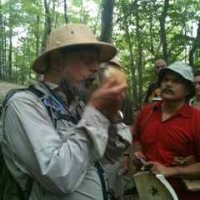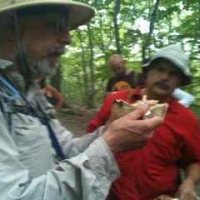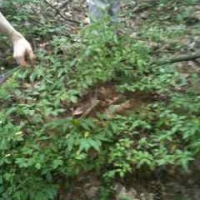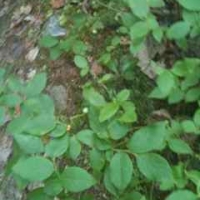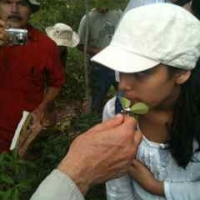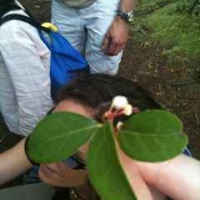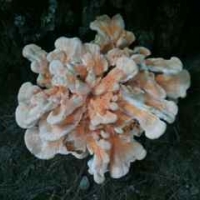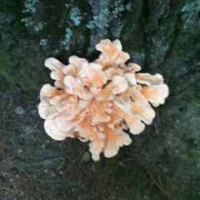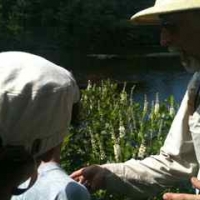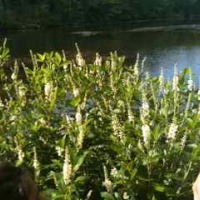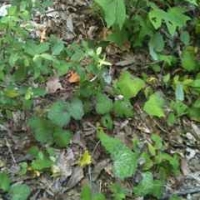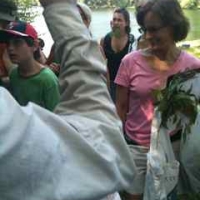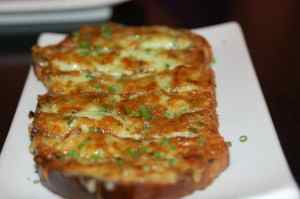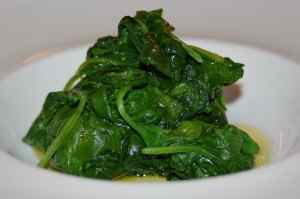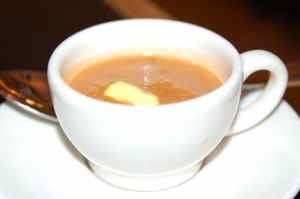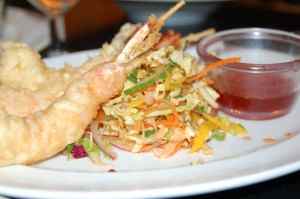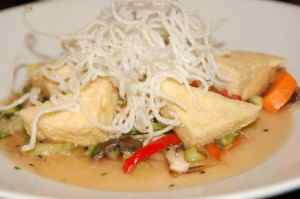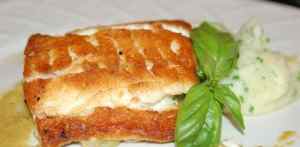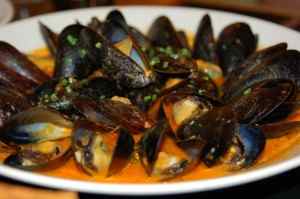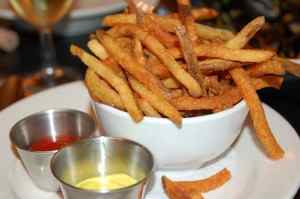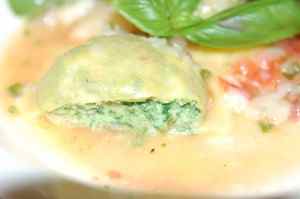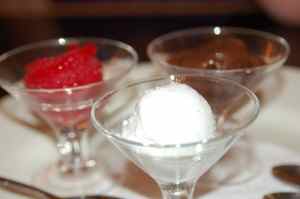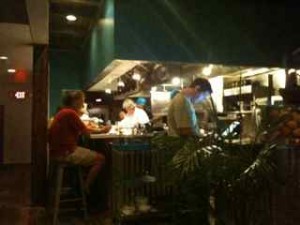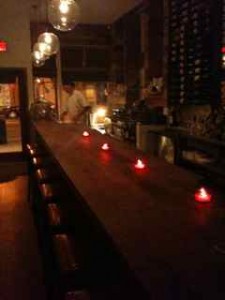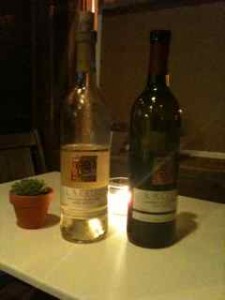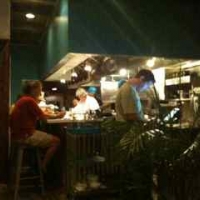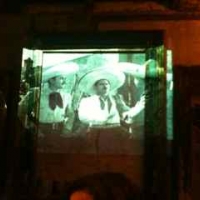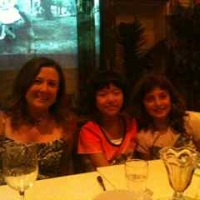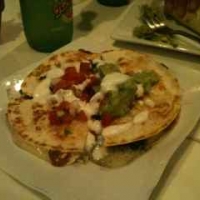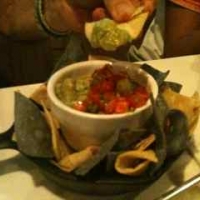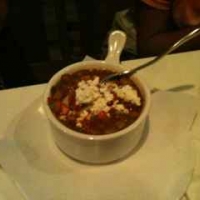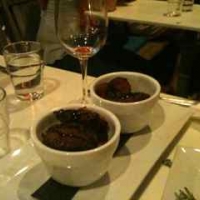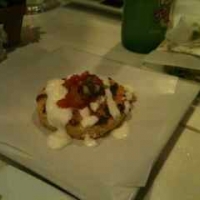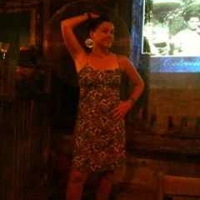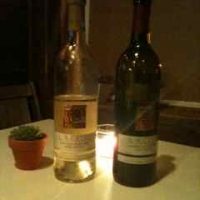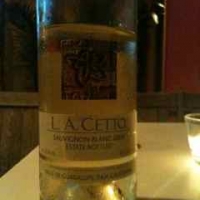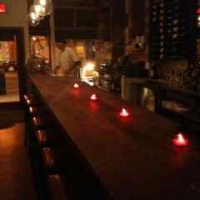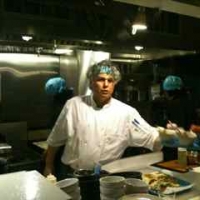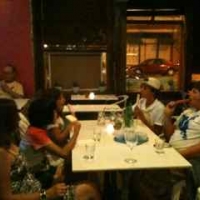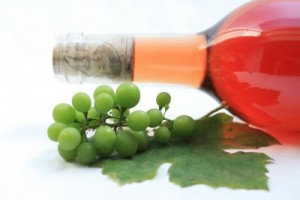 What is it about summertime that turns even the most ardent red wine drinkers into white wine sippers? Is it the hot summer days? The need for something cold and refreshing? Well, yes. But it’s also the acidity found in many white wines. The natural acids found in grapes (eg. tartaric, malic, citric) begin to decrease at the moment the grapes begin to ripen, or when the sugar content begins to increase. Winemaking is a balancing act between sweet (sugar) and sour (acid) in which the winemaker must harvest the grapes at the optimal time when sugar and acid are well balanced. A good amount of acidity adds brightness to a wine. Too much acid, and wine will taste tart or even sour. Too little acid, and the wine will appear what is often referred to as “flabby” or “flat.”
What is it about summertime that turns even the most ardent red wine drinkers into white wine sippers? Is it the hot summer days? The need for something cold and refreshing? Well, yes. But it’s also the acidity found in many white wines. The natural acids found in grapes (eg. tartaric, malic, citric) begin to decrease at the moment the grapes begin to ripen, or when the sugar content begins to increase. Winemaking is a balancing act between sweet (sugar) and sour (acid) in which the winemaker must harvest the grapes at the optimal time when sugar and acid are well balanced. A good amount of acidity adds brightness to a wine. Too much acid, and wine will taste tart or even sour. Too little acid, and the wine will appear what is often referred to as “flabby” or “flat.”
Acid in white wine can produce a thirst-quenching sensation. White wines with good acidity both pair well with a wide variety of foods and prepare the palate for the food. Acid helps wine stand up to foods high in salt, fat and rich proteins. Another benefit of acid is its role in wine longevity, helping some wines age longer and preventing browning and microbial spoilage. So, instead of grabbing a glass of California chardonnay with oak and high alcohol content that make it a food pairing problem, reach for a nice, crisp sauvignon blanc or riesling instead. Cheers!
The Summer Wine Acid Test
WINE to Present at Putnam County International Wine & Food Fest
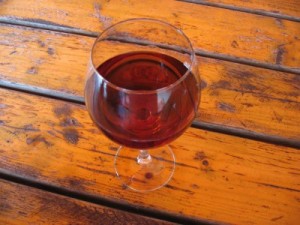 The Wine Institute of New England will be presenting a Wine Appreciation and Tasting Tips class at the First Annual Putnam County International Wine & Food Fest on Sunday, August 14th, 2011. The festival will be held at Putnam County Veterans Memorial Park, Carmel, New York on August 13th from 10-7 and August 14th from 10-4. Some of New York’s finest wineries will be represented, as well as local and international retailers, food vendors, and arts & crafts vendors. For more details on this event, please go to the following website: http://www.putnamcountywinefest.com
The Wine Institute of New England will be presenting a Wine Appreciation and Tasting Tips class at the First Annual Putnam County International Wine & Food Fest on Sunday, August 14th, 2011. The festival will be held at Putnam County Veterans Memorial Park, Carmel, New York on August 13th from 10-7 and August 14th from 10-4. Some of New York’s finest wineries will be represented, as well as local and international retailers, food vendors, and arts & crafts vendors. For more details on this event, please go to the following website: http://www.putnamcountywinefest.com
First CT Farmer’s Market Wine Permit Issued!
In June 2011, AN ACT AUTHORIZING THE SALE OF CONNECTICUT WINE AT FARMERS’ MARKETS AND ESTABLISHING A FARMERS’ MARKET WINE PERMIT was signed into law. Keith Bishop of Bishop’s Orchards Winery, our June Connecticut Corker, was instrumental in bringing about this critical legislation. (For more about Keith’s involvement, click here: https://wineinstituteofnewengland.com/bishops-orchards/) Therefore, it seems only fitting that Bishop’s Orchards Winery is the one to obtain the very first Connecticut Farmer’s Market Wine Permit. Following is the press release with the details of this exciting milestone:
Wine Sales Start at Milford Farmers Market
August 2, 2011
For Immediate Release:
Toast your local Farmers Market! Buy a bottle of CT Farm Wine and raise your glass.
Bishop’s Orchards Farm Market & Winery just obtained CT Farmer’s Market Wine Permit #1 to sell wine at the Woodmont Farmer’s Market every Wednesday afternoon. Now wine can be bought direct from the 140 year old family farm at the same time you get flowers, vegetables, fish, fresh baked goods, cheese and more at the weekly Farmers Market held at the Robert Treat Farm on New Haven Ave in Milford from 3.30-6.30 every Wednesday.
Winemaker Keith Bishop, Treasurer of the CVWA’s Wine Trail worked with the CT Legislature and Farm Bureau to put Connecticut on the same footing as NY and MA that allow their Farmer’s Markets to sell wine. The Governor signed PA 11-164 on July 13 and Bishop’s permit was issued July 27.
24 Wineries make up the CT Wine Trail and are showcased at www.ctwine.com. Ct Farm Wineries typically sell direct at their farms, with few large enough to bear distribution costs to wholesale their products. Being able to sell at Farmers Markets will benefit wineries and consumers: opportunities for new customers, and less travel to repeatedly visit the winery and support local farms and keep land in viable production. Liquor regulations are still complex, and the wineries take their roles seriously for age verification and patron safety. Local regulations will prohibit some Farmers Markets from allowing Wineries to sell, as some zoning or local ordinances don’t allow alcohol on city property, such as New Haven.
Bishop’s Orchards Winery makes fruit wines and Hard Cider exclusively from fruits grown on their 313 acre farm. Apple Raspberry Blush, HAppley ImPeared, Celebration and Stone House White are among their selection of 18 wines made. Stone House White was awarded a Gold Medal at the 2011 Finger Lakes International Wine Competition, and HAppley ImPeared was awarded a Gold Medal at the 2011 International Eastern Wine Competition. In all, Winemaker Keith Bishop earned 53 medals in 4, 2011 International Competitions, including 4 Silver Medals for Apple Raspberry Blush.
The 5th Annual Shoreline Wine Festival will be hosted by Bishop’s Orchards on August 13 & 14 and feature top CT Wineries, food, seminars, entertainment, tours and sales of wine by the bottle and case. Tickets and information is at shorelinewinefestival.com.
Since 1871, six generations of Bishop’s have been serving Connecticut with the best possible farm products. Bishop’s Orchards Farm Market is open all-year round and is a destination for the area’s finest food and wholesome family fun. Every season The Bishop Family offers new and traditional foods and experiences. From the large retail farm market to their Pick Your Own Fruit program June thru October to their winery that has tastings available 7 days a week, Bishop’s is the perfect destination for people of all ages. Bishop’s Orchards, 1355 Boston Post Road, Guilford, CT, 203-453-2338, www.bishopsorchards.com.
Contact:
Bishop’s Orchards Farm Market and Winery:
Keith Bishop or Sarah Dellaventura 203-453-2338
Woodmont Farmers Market:
Mary Treat (203)878-4270
The 5th Annual Shoreline Wine Festival
Feeling left out because you didn’t make it to the Connecticut Wine Festival? Or maybe you had such a great time there you really want some more? Well, you’re in luck. Bishop’s Orchards Winery will be hosting the The 5th Annual Shoreline Wine Festival on Saturday and Sunday, August 13th-14th at Bishop’s Orchards Farm Market and Winery, 1355 Boston Post Road, Guilford, CT. 10 of Connecticut’s finest wineries will be participating. And, if you act now, you can purchase tickets for $25 per person. That’s a $5 savings off of the door price. Hope you can make it!
For more information on the Shoreline Wine Festival, visit this site: http://shorelinewinefestival.com/
Discoveries and Rediscoveries at The Connecticut Wine Festival
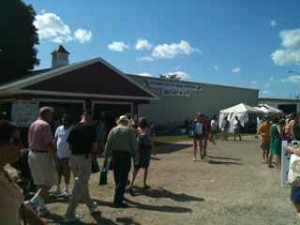 It was a perfect summer day for the throngs of people who streamed into the Goshen Fair Grounds to partake in the third annual Connecticut Wine Festival this weekend. Over 8,000 attendees tread the grounds during the course of the weekend, a remarkable 50% increase from last year’s event, according to Festival Chairman, George Motel. Mr. Motel’s winery, Sunset Meadow Vineyards, was one of fourteen Connecticut wineries represented, all of which are members of the Connecticut Wine Trail. (http://ctwine.com/) Specialty food vendors, jewelers and musicians were also represented. Upon entering the grounds, friendly women clad in purple tee shirts handed out programs, wine totes and wine glasses etched with the words “Connecticut Wine Festival.” This would be the one and only glass I would use throughout the event so I made sure to baby it as I headed out on my wine quest. The wineries were set up inside two buildings, segregated by their location in the state – Eastern Connecticut and Western Connecticut. One hour into the event, and the crowds were already gathered four rows deep in front of every winery. Each winery was strictly limited to pouring only four of their wines. Most wineries opted for a combination of white and red wines, with the occasional rosé making an appearance. Water pitchers and spit buckets were at the ready. Friendly and knowledgeable people poured briskly, trying to keep pace with the eager tasters. Many of the winery owners, themselves, were pouring the wine and answering questions. If a taster found something she particularly cared for, she could opt to buy a glass of it for drinking right on the spot, or purchase a bottle to consume on the grounds or at home.
It was a perfect summer day for the throngs of people who streamed into the Goshen Fair Grounds to partake in the third annual Connecticut Wine Festival this weekend. Over 8,000 attendees tread the grounds during the course of the weekend, a remarkable 50% increase from last year’s event, according to Festival Chairman, George Motel. Mr. Motel’s winery, Sunset Meadow Vineyards, was one of fourteen Connecticut wineries represented, all of which are members of the Connecticut Wine Trail. (http://ctwine.com/) Specialty food vendors, jewelers and musicians were also represented. Upon entering the grounds, friendly women clad in purple tee shirts handed out programs, wine totes and wine glasses etched with the words “Connecticut Wine Festival.” This would be the one and only glass I would use throughout the event so I made sure to baby it as I headed out on my wine quest. The wineries were set up inside two buildings, segregated by their location in the state – Eastern Connecticut and Western Connecticut. One hour into the event, and the crowds were already gathered four rows deep in front of every winery. Each winery was strictly limited to pouring only four of their wines. Most wineries opted for a combination of white and red wines, with the occasional rosé making an appearance. Water pitchers and spit buckets were at the ready. Friendly and knowledgeable people poured briskly, trying to keep pace with the eager tasters. Many of the winery owners, themselves, were pouring the wine and answering questions. If a taster found something she particularly cared for, she could opt to buy a glass of it for drinking right on the spot, or purchase a bottle to consume on the grounds or at home.
My first stop was Jonathan Edwards Winery where they offered pours of both Connecticut grown and Napa grape wines. Jones Winery brought crisp chardonnay and refreshing First Blush, a blend of apples, pears and black currants and the perfect antidote to the heat. Sunset Meadow Vineyards, always a crowd pleaser, had Sunset Blush and Cayuga White on hand. I was especially excited to visit their table after recently spending an evening at their vineyard for a beautifully put-together and well-paired farm to chef wine dinner. Other interesting finds included the Hungarian grape, bianca, and the pinot noir mutation, corot noir, at Land of Nod, a 100% riesling flavored with natural peach essence from Taylor Brooke Winery, and a lovely Alsatian-style riesling from Priam Vineyards, bottles of which were just flying out of the booth. I made sure to stop by Sharpe Hill Vineyard for a taste of
their renowned Ballet of Angels, a semi-dry white that is a proprietary blend of 12-14 grapes. Most, if not all, of the wineries offered the off-dry to semi-sweet wines so popular in this state, with only the occasional truly dry wine being found. Bishop’s Orchards Winery and White Silo Farm, both fruit wine specialists, saw a steady stream of sippers.
As I navigated the lines from winery to winery, I stopped to chat with as many people as I could to find out where they had come from and what wines they were enjoying the most. All corners of the state were represented and every guest had their own wine preference – some sweeter, some drier, some fruit. Some guests seemed knowledgeable about Connecticut wineries, already professing a favorite from prior visits along the Connecticut Wine Trail, while others were discovering our state’s wineries for the very first time. One Connecticut resident out supporting local agriculture on Sunday was Governor Malloy, who made a personal appearance at the Festival and visited all 14 of the wineries. Apparently, he was so inspired by what he found that, after the Festival, he paid a visit to Sunset Meadow Vineyards for a tour, and returned to the Governor’s mansion with at least a few bottles in tow. Overall, the crowd was very young, comprising approximately 60-70% of the total guests. According to Mr. Motel, last year’s group comprised a similar makeup. I stopped to talk to two women taking a momentary hiatus from imbibing. Lynn Allen and Carrie Traverse, from Wallingford and East Haven, respectively, were visiting the Festival for the second year. And although they remarked, as many did, on the number of people present, it was clearly not an obstacle to an enjoyable time. They were especially appreciative of the appearance of the fans this year. Both women had previously been to the two wineries in Wallingford, Gouveia Vineyards and newcomer Paradise Hills Vineyard, and were hopeful to see Paradise Hills included in next year’s Festival.
For those requiring some sustenance to get them through the afternoon, food vendors could be found both inside the
buildings and elsewhere on the grounds. Lunch selections included chicken and beef on sticks, fresh potato chips, organic beef burgers and, of course, cheese platters. I noticed there was a constant crowd of people at Little Sister’s Grilled Cheese truck where one could get a variety of grilled cheese sandwiches, including goat cheese with honey, or tomato, mozzarella and basil. After bumping into winery owner, Eric Gorman, at the Blue Moon booth buying cheeseburgers for his staff, I was persuaded to head back inside to sample some rhubarb wine from his winery, White Silo Farm. I was greatly rewarded. The white rhubarb wine was delicate, slightly tart and quite pleasing.
Back outside, I came upon a tented section showcasing several specialty food vendors, including Ola! Granola, Cato Corner Farm and Peace Tree Desserts. I picked up a few items at each of these tables, including some heavenly Applejack Cajeta Caramel from Peace Tree. Owner, sustainable pastry chef, Robyn Eads, told me this authentic Mexican style caramel sauce was handcrafted with goat’s milk from Connecticut family farms. It was so delectable, I decided to bring home the Curry Cajeta Caramel, as well.
Although not a recreational activity for those shy of crowds, the Connecticut Wine Festival provides a wonderful opportunity to see and taste what Connecticut wineries are creating in a festive and friendly atmosphere, as well as sample some of Connecticut’s specialty food offerings. Will the Connecticut Vineyard & Winery Association be sponsoring a fourth Connecticut Wine Festival? Absolutely. As Mr. Motel explains, “This is a great event for (Connecticut wineries) to showcase our wines and create better awareness of the Connecticut Wine Trail.” Current plans are to keep the event at the Goshen Fair Grounds and to spread the wineries out a little more to better effectuate flow of traffic. I have no doubt that I will be heading back up to Goshen next year to participate in this fun and well-run event.
Loose Tannins
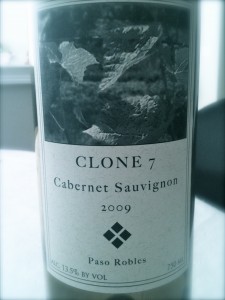 If you drink red wine, you have probably at least heard the word “tannins” in connection with either the taste or the physical sensation produced when you drink the wine. But what exactly are tannins? Tannins are phenolic compounds present in the skin, seeds and stems of grapes, and in the oak used for barrels. The longer the juice of red grapes is kept in contact with these solid parts, the more tannic the wine can become. Tannins are detectable in two ways: 1) a bitter taste; and 2) astringency – a cotton mouth feeling that occurs when tannins react with protein in the drinker’s saliva. They are also responsible for intense pigment in wine. Tannins bond with proteins in wine and precipitate out as the wine ages, causing the wine to become less harsh and less intense in color. Although oak cooperage can also contribute to tannins, it is not a significant amount. Tannin levels vary from grape to grape. The four most tannic grapes in the world are cabernet sauvignon, nebbiolo, syrah, and tannat. Pinot noir, by comparison, has half the tannin content of cabernet sauvignon. Personally, I just adore loose tannins. Cheers!
If you drink red wine, you have probably at least heard the word “tannins” in connection with either the taste or the physical sensation produced when you drink the wine. But what exactly are tannins? Tannins are phenolic compounds present in the skin, seeds and stems of grapes, and in the oak used for barrels. The longer the juice of red grapes is kept in contact with these solid parts, the more tannic the wine can become. Tannins are detectable in two ways: 1) a bitter taste; and 2) astringency – a cotton mouth feeling that occurs when tannins react with protein in the drinker’s saliva. They are also responsible for intense pigment in wine. Tannins bond with proteins in wine and precipitate out as the wine ages, causing the wine to become less harsh and less intense in color. Although oak cooperage can also contribute to tannins, it is not a significant amount. Tannin levels vary from grape to grape. The four most tannic grapes in the world are cabernet sauvignon, nebbiolo, syrah, and tannat. Pinot noir, by comparison, has half the tannin content of cabernet sauvignon. Personally, I just adore loose tannins. Cheers!
Wild Wines
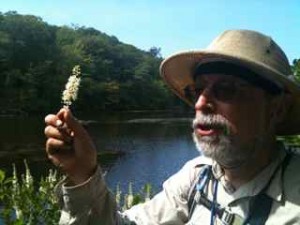 Wildman Steve Brill has been leading foraging tours since his first public excursion in Central Park on April 24th, 1982. The fact that he was arrested in Central Park in the mid ‘80s for eating a dandelion did more to boost his career than all of his knowledge, good story-telling and self-promoting combined. After receiving feedback from followers that his looks did not seem “wild” enough for a man who combs the forest for food, Wildman grew a beard and purchased a pith helmet to fit the part. Foraging for wild edibles is Wildman’s passion and, when you follow your passion, good things happen. In addition to providing a 30-year long career, foraging is what led the Wildman to his wife. The couple met when Steve led a foraging tour for singles, and the two have been foraging together ever since. These days, the outings include their 7-year old daughter, Violet, who has a knack for spotting wild edibles, and has even led a tour with her father for her former first grade class. One of Wildman’s best moments came when the great grandson of the brother of jazz musician, Bix Beiderbecke, attended an outing. Wildman is a great lover of jazz and performs his own version of the music in a technique he calls “Brillophone.” “Its legitimate jazz,” Steve says. On several occasions, he has been invited to jam with bands playing in Central Park.
Wildman Steve Brill has been leading foraging tours since his first public excursion in Central Park on April 24th, 1982. The fact that he was arrested in Central Park in the mid ‘80s for eating a dandelion did more to boost his career than all of his knowledge, good story-telling and self-promoting combined. After receiving feedback from followers that his looks did not seem “wild” enough for a man who combs the forest for food, Wildman grew a beard and purchased a pith helmet to fit the part. Foraging for wild edibles is Wildman’s passion and, when you follow your passion, good things happen. In addition to providing a 30-year long career, foraging is what led the Wildman to his wife. The couple met when Steve led a foraging tour for singles, and the two have been foraging together ever since. These days, the outings include their 7-year old daughter, Violet, who has a knack for spotting wild edibles, and has even led a tour with her father for her former first grade class. One of Wildman’s best moments came when the great grandson of the brother of jazz musician, Bix Beiderbecke, attended an outing. Wildman is a great lover of jazz and performs his own version of the music in a technique he calls “Brillophone.” “Its legitimate jazz,” Steve says. On several occasions, he has been invited to jam with bands playing in Central Park.
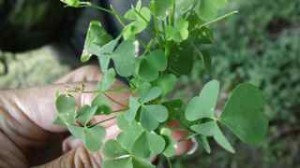 So what drew Wildman into the world of foraging? A love of cooking and ethnic foods played a large role. He remembers seeing a group of Greek women picking something wild in his hometown in Queens one day. He ended up heading home with a handful of grape leaves which he stuffed and enjoyed that evening. A self-taught forager, Steve feels his most impressive credential is that he hasn’t lost a tour member yet to a poisonous plant. And the tour members keep coming. Several people called to reserve spots in upcoming outings while Steve and I spoke. The day I went on my tour, 62 other people showed up. Wildman has a talent for storytelling and is a natural educator, especially of children. Three young boys hiked alongside Wildman for a large portion of our 3-hour journey, asking questions and soaking in the stories. When I called to interview Wildman, he informed me that he had just returned from a bicycle tour with inner-city kids. The bikes they used were made up of recycled parts. I told him my day’s outing had been cut short by the unfortunate disturbance of a wasp nest and several painful stings. “Did you find some jewel weed?” Steve asked me. “It cuts the pain in half.” I had, in fact, just learned this on the recent outing he led, but did not have the presence of mind to forage for it in my wounded state. Maybe next time.
So what drew Wildman into the world of foraging? A love of cooking and ethnic foods played a large role. He remembers seeing a group of Greek women picking something wild in his hometown in Queens one day. He ended up heading home with a handful of grape leaves which he stuffed and enjoyed that evening. A self-taught forager, Steve feels his most impressive credential is that he hasn’t lost a tour member yet to a poisonous plant. And the tour members keep coming. Several people called to reserve spots in upcoming outings while Steve and I spoke. The day I went on my tour, 62 other people showed up. Wildman has a talent for storytelling and is a natural educator, especially of children. Three young boys hiked alongside Wildman for a large portion of our 3-hour journey, asking questions and soaking in the stories. When I called to interview Wildman, he informed me that he had just returned from a bicycle tour with inner-city kids. The bikes they used were made up of recycled parts. I told him my day’s outing had been cut short by the unfortunate disturbance of a wasp nest and several painful stings. “Did you find some jewel weed?” Steve asked me. “It cuts the pain in half.” I had, in fact, just learned this on the recent outing he led, but did not have the presence of mind to forage for it in my wounded state. Maybe next time.
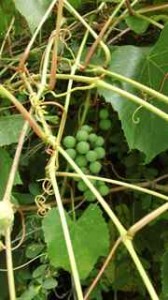 Now it was time to discuss the reason for my call – to learn more about what Wildman calls his “wild wines,” wines made from wild edibles. The very first wild wine Steve made was a dandelion wine in the 1980s. He had seen books that talked about making wines from foraged edibles, including those by Euell Gibbons, author of books on natural foods and proponent of natural diets during the 1960s, and he knew that dandelion wine was being made in Italy. For this inaugural wine, Steve foraged dandelions from Cunningham Park in Queens during the peak of their growing season, mid-April. A very labor intensive wine, only the yellow parts of the flowers were used because the green sepals are too bitter. For citrus flavor, he added some lime, poured boiling water over everything and let it cool to lukewarm. He then blended in a wine yeast purchased at a winemaking supply store in Little Italy and fermented the mixture in an open plastic food tub. Apparently, the wine came out great. Steve is not much of a wine drinker himself, but he enjoyed experimenting with several varieties of wine, some of which he used for cooking. Ramp wine was one reserved solely for cooking as the wine had a garlicky flavor that worked well in recipes, but was not pleasant to drink. Other more potable wines created by Wildman included those made from wisteria, black locust, red bud, pink mulberry, wine berry, autumn olive, wild currant, day lily, pineapple weed, apple blossom and, Steve’s favorite, oak leaf. He is not currently making wild wines because the many gallons he created have a long shelf life. For those of you inspired to try this at home, several recipes for wines made from wild edibles can be found in Wildman Steve Brill’s, The Wild Vegan Cookbook. For a list of upcoming outings, go to wwww.wildmanstevebrill.com.
Now it was time to discuss the reason for my call – to learn more about what Wildman calls his “wild wines,” wines made from wild edibles. The very first wild wine Steve made was a dandelion wine in the 1980s. He had seen books that talked about making wines from foraged edibles, including those by Euell Gibbons, author of books on natural foods and proponent of natural diets during the 1960s, and he knew that dandelion wine was being made in Italy. For this inaugural wine, Steve foraged dandelions from Cunningham Park in Queens during the peak of their growing season, mid-April. A very labor intensive wine, only the yellow parts of the flowers were used because the green sepals are too bitter. For citrus flavor, he added some lime, poured boiling water over everything and let it cool to lukewarm. He then blended in a wine yeast purchased at a winemaking supply store in Little Italy and fermented the mixture in an open plastic food tub. Apparently, the wine came out great. Steve is not much of a wine drinker himself, but he enjoyed experimenting with several varieties of wine, some of which he used for cooking. Ramp wine was one reserved solely for cooking as the wine had a garlicky flavor that worked well in recipes, but was not pleasant to drink. Other more potable wines created by Wildman included those made from wisteria, black locust, red bud, pink mulberry, wine berry, autumn olive, wild currant, day lily, pineapple weed, apple blossom and, Steve’s favorite, oak leaf. He is not currently making wild wines because the many gallons he created have a long shelf life. For those of you inspired to try this at home, several recipes for wines made from wild edibles can be found in Wildman Steve Brill’s, The Wild Vegan Cookbook. For a list of upcoming outings, go to wwww.wildmanstevebrill.com.
A Rosé By Any Other Name…
It seems everyone is drinking rosés right now, even those of us who used to eschew them as not being serious enough to tempt our palates. I confess to being a convert in this regard. But many people still seem confused about how a rosé is actually made. The most common misconception I have run across is the belief that rosé is made from red wine diluted with white wine to achieve the pink color. Let us consider this misconception dispelled. Rosé is made by crushing red wine grapes to begin extracting color and flavor from the skins. Once enough color is extracted to produce that beautiful pink hue (usually between one hour and two days), the solids are removed. The juice is then fermented with the same method used for white wine. Dry or semi-sweet, these wines are fruity with medium to high acidity.
As for other names…sweeter rosés are often labeled “blush,” single variety wines may be termed “white” as in “white zinfandel, and these style wines from Spain, Italy and Germany are called rosado, rosato and weissherbst, respectively. But a rosé by any other name…
Wowed by the West Street Grill
I recently spent a lovely weekend with friends enjoying Connecticut wine and food in Litchfield County, the culmination of which was a multi-course lunch at West Street Grill. Following are our impressions of the food and wine.
By Analiese Paik and Elizabeth Keyser
Wine Review by Renée B. Allen
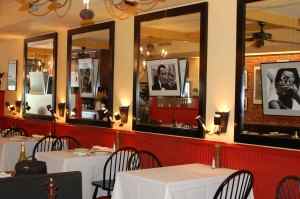
New restaurants get all the buzz, but on day two of the Litchfield road trip it was easy to pass up the darling of the moment for the real thing: a long-established restaurant that puts care into the entire experience of its guests.
Yes, we’re talking about the West Street Grill in Litchfield. For over 20 years restaurateurs James O’Shea and Charles Kafferman have been serving excellent New American food with a French/Mediterranean influence. A day or weekend trip to Litchfield is not complete without a meal at this iconic restaurant, which is known for being a haunt of many well-known actors and writers. O’Shea was once asked why so many celebrities eat there. “We leave them alone,” he replied. Actually, he takes very good care of his guests and is known for telling a funny story — or two or three.
The black and white photos in the front dining room are from a 1950’s photo collection that are rotated regularly. The old-world feel immediately gives you the impression that they take food and hospitality very seriously.
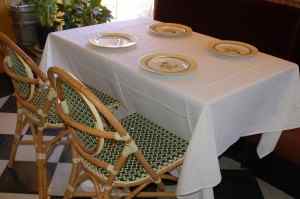 In the back dining room where renovations are well underway, the Mediterranean style plates decorated with fruited lemon and olive sprigs appeared as the tables were turned for dinner service. The original rattan French bistro chairs are caned in a dark green and ivory open weave, true to the original style, and a perfect match for the restaurant’s awning colors.
In the back dining room where renovations are well underway, the Mediterranean style plates decorated with fruited lemon and olive sprigs appeared as the tables were turned for dinner service. The original rattan French bistro chairs are caned in a dark green and ivory open weave, true to the original style, and a perfect match for the restaurant’s awning colors.
The French bistro-inspired atmosphere is inviting, the service is on a professional level rarely seen, but West Street Grill is really about the food. It was one of the earliest proponents of farm-to-table (“before the term was coined,” says O’Shea), and at a recent lunch, the fresh ingredients were the stars in the room. Executive Chef Jimmy Cosgriff is the star in the kitchen.
The West Street Grill picks up fresh tomatoes, basil, blueberries, peaches, lettuces and arugula from local farms. Dean’s Farm Stand in Fall’s Village provides beets, basil, potatoes and some tomatoes. Waldingfield Farm in Washington, a certified organic vegetable farm that grows a variety of heirloom tomatoes, is another source. Milk from local farms is used to make the house ricotta. O’Shea grows some of his own tomatoes, organically of course, as well as rhubarb, lettuces, and large amounts of herbs like lovage, chives, Russian and pineapple sage, lemon balm, tarragon, horseradish, opal shiso and purple basil. “We are heavy chive and basil users,” he said. He buys all his vegetable seedlings from USDA organic grower Gilbertie’s Herb Gardens. Honey, maple syrup and some other products come from the farmers’ market. West Street Grill also uses Baldor, which sources from local farms from a 300 mile radius.
Lunch was superb.
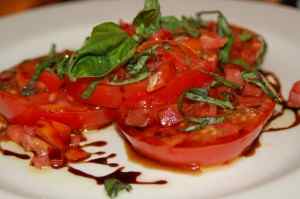 W.S.G. Locally Grown Tomato Salad with native basil, fleur de sel and 12 year aged balsamic vinegar
W.S.G. Locally Grown Tomato Salad with native basil, fleur de sel and 12 year aged balsamic vinegar
These perfectly ripe tomatoes were a natural starter for a hot day. They were rich in fresh, tomato flavor.
Parmesan Aioli Peasant Bread
Intensely flavorful with a satisfying crunch from the gratin and toasted house-made bread, this has been a house classic since 1990.
Sauteed Spinach
Baby spinach, picked up that morning from a local farm, was wilted and served simply to let the natural flavors shine. It melted like butter in the mouth.
Soup de Poisson, aioli and garden chives
Rich with roasted fish and vegetables, the soup was hearty and was flavored with fennel. It was topped with an understated aioli; a more forceful aioli would have overwhelmed the soup.
Shrimp Tempura
Gulf shrimp were skewered straight and perfectly cooked so they were meltingly tender on the inside, crisp and slightly golden on the outside. They were served with a refreshing salad of Napa cabbage, mango, cilantro, peanuts, Bermuda onion, carrot and pickled ginger along with sweet chili dipping sauce.
Pan Seared Silken Tofu
Triangles of fresh tofu lightly seared and served with wok-seared vegetables seasoned with scallion, cilantro, pickled ginger. The dish was topped with crispy rice noodles with sweet chili sauce.
Fresh, Wild, Day-Boat, Connecticut Fluke with potato puree, braised leeks, lemon caper coulis
The pan-seared fluke (summer flounder) was golden and crisp, yet so tender it was hard to believe it wasn’t breaded. “Nothing comes between a fish and my chef’s pan,” O’Shea told us. Hidden beneath the fish were ribbons of leek. The herbed potato puree was light and delicate, and was accented by the lemon caper coulis. This dishes hit the mark on both flavor and execution.
Moules Frites
The mussels were steamed in a gorgeous broth of garlic, lemon, white wine and tomato. The broth was clean, delicate and well-balanced. The fries were crunchy and delicious, especially when dipped into the saffon-scented aioli.
“Jimmy’s Ravioli” — Homemade Spinach and Gorgonzola Ravioli with garlic, grape tomatoes, basil, grana padano
Two plump pillows of light-as-air ravioli offered the perfect filling-to-dough ratio so the focus was on the filling, rather than the pasta that enrobed it. The filling’s silky smooth texture came from house-made ricotta from local milk, blended with spinach, gorgonzola and Parmesan cheese. A brothy, delicate sauce of fresh tomatoes, garlic, basil and grana padano created a very refined ravioli.
Dessert
A trio of coconut, raspberry and chocolate sorbets was refreshing and bursting with flavor – pieces of coconut, ripe raspberries, dark chocolate with no bitterness. None were overly sweet, which we appreciated.
Wine Review by Renée B. Allen
Casa Julia Sauvignon Blanc, Chile 2010
Our decadent dining experience began with a Chilean Sauvignon Blanc from Casa Julia, a vineyard with a solid, hands-on approach to sustainable agriculture. Chilean Sauvignon Blanc has progressed by leaps and bounds in the past 10 years. Winemakers have been exploring cooler regions in Chile for growing these grapes with phenomenal results. This example from Casa Julia exhibited many of the traits found in these successful plantings. To begin, slightly muted notes of tropical fruits danced on the nose, hinting at the riches to be found within. These tropical notes revealed themselves on the tongue richly, but without the aggression often associated with warmer climate Sauvignon Blancs. The midpalate opened to a wave of citrus which was followed by a crisply acidic and well structured finish. This wine is tailor-made for drinking with seafood and proved a worthy pairing for the Soup de Poisson.
The Vineyard at Strawberry Ridge Ascot Reserve Chardonnay, Western Connecticut Highlands 2008
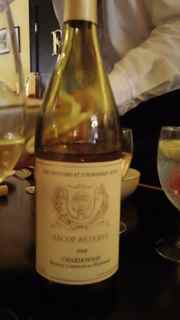 For our second wine, James O’Shea insisted on what he claimed to be the best wine in Connecticut, the Ascot Reserve Chardonnay from The Vineyard at Strawberry Ridge in Connecticut. The vineyard owners, Robert and Susan Summer, have hired Connecticut vintner Jonathan Edwards to produce this wine. Probably the best traveled wine in Connecticut, from New York to Las Vegas all the way to Macau, the list of venues carrying this limited production wine reads like a celebrity “it” list. The vineyard’s most recent accolade is their production of the wines for the famed Rao’s restaurant in New York. The wine opened with aromas of vanilla, apple and caramel, delicately punctuated with hints of nutmeg. The first fleeting taste to tantalize the tongue was green apple, which quickly yielded to butterscotch on the midpalate from the use of French oak barrels during fermentation. The finish ended with notes of fig and citrus, and tongue-smacking astringency. Although this wine bore little resemblance to the flinty, mineralic, stainless steel fermented Chardonnays most commonly associated with Connecticut, it was an admirable example of the influence the vintner wields over the Chardonnay grape. This wine was a nice complement to the Pan Seared Connecticut Fluke, which might just have been the best fish dish ever to grace this wine taster’s lips.
For our second wine, James O’Shea insisted on what he claimed to be the best wine in Connecticut, the Ascot Reserve Chardonnay from The Vineyard at Strawberry Ridge in Connecticut. The vineyard owners, Robert and Susan Summer, have hired Connecticut vintner Jonathan Edwards to produce this wine. Probably the best traveled wine in Connecticut, from New York to Las Vegas all the way to Macau, the list of venues carrying this limited production wine reads like a celebrity “it” list. The vineyard’s most recent accolade is their production of the wines for the famed Rao’s restaurant in New York. The wine opened with aromas of vanilla, apple and caramel, delicately punctuated with hints of nutmeg. The first fleeting taste to tantalize the tongue was green apple, which quickly yielded to butterscotch on the midpalate from the use of French oak barrels during fermentation. The finish ended with notes of fig and citrus, and tongue-smacking astringency. Although this wine bore little resemblance to the flinty, mineralic, stainless steel fermented Chardonnays most commonly associated with Connecticut, it was an admirable example of the influence the vintner wields over the Chardonnay grape. This wine was a nice complement to the Pan Seared Connecticut Fluke, which might just have been the best fish dish ever to grace this wine taster’s lips.
Geyser Peak Cabernet Sauvignon, Alexander Valley 2007
The powerful, classic Geyser Peak Cabernet Sauvignon proved an excellent companion to the Homemade Spinach & Gorgonzola Ravioli. Everything a cab should be, this wine’s bouquet foretold the fruit and spice that awaited the taster. In a beautiful balance of fruit forwardness and medium tannins, black cherry and chocolate, accentuated by pepper, coated the palate, before succumbing to the lingering finish.
West Street Grill
48 West Street, Litchfield, 06759
www.weststreetgrill.com
Reprinted with permission from www.fairfieldgreenfoodguide.com
Authentic Mexican Food and Wine ~ a Tijuana-style Summer Night
When people comment on how fun my job must be, I always say, “the research doesn’t stink.” This is never truer than when I get to combine terrific food with whatever wine I am tasting. Such was the case this week when I had the pleasure of tasting two Mexican wines while being treated to authentic Mexican cuisine at Suzette and Arturo Franco-Camacho’s newest food child, Tacuba Taco Bar. Tacuba is the name of a municipality in northwest Mexico City. With this latest restaurant, Chef Franco-Camacho honors his Mexican heritage and his mother’s taqueria in Tijuana where he grew up.
My friend and I arrived, with four kids in tow, after spending the day melting from the heat wave moving through Connecticut. We were tired but looking forward to a relaxing evening out in an air-conditioned restaurant. Upon opening the door to the unassuming entrance, we were struck with another heat wave; the air conditioning was out. Undaunted, I strolled in and gave the host my name. My companions followed reluctantly. It was not long into the meal before everyone agreed that we had made the right decision by staying, and that the heat added a touch more authenticity.
Although I am a tried and true foodie, I will save the majority of my prose for the wine and limit the food commentary to one simple sentence – everything was delicious and reasonably priced. The décor is pleasant and fun, a colorful montage of Mexican accented with contemporary touches, such as corrugated aluminum. A giant picture frame on the wall offers a canvas for silently run black and white Mexican movies, a great distraction for the hot and somewhat restless children. In the open kitchen, one can watch Chef Franco-Camacho creating culinary magic. If you really like to be part of the action, you can sit at the counter area directly in front of the kitchen. On the other side of a partitioning wall is the very adult bar, “Swill.” I had to run my hand over the wood bar and feel the natural undulations. A chandelier composed of wine glasses provided the very low mood lighting.
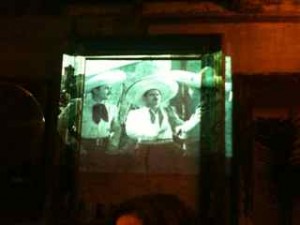
Back in the dining area, we were given menus with only two wines listed: Mexican sauvignon blanc and Mexican cabernet sauvignon. If you are not a wine drinker, there are mixed drinks, beers and 24, that’s right, 24, tequilas to choose from. But if you do like wine, I highly recommend you try one of the Mexican offerings. They go well with the food. I am hoping to return soon, minus the children, to conduct further research at Swill.
L.A. Cetto Sauvignon Blanc 2009
The nose was slightly grassy with tropical fruit notes. Herbaceousness and stone fruits were evident in this mineralic, medium oaked, unassuming wine.
L.A. Cetto Cabernet Sauvignon 2008
The cab also had a mineralic and somewhat flinty taste, with dark red berries, cassis and a bit of earthiness. Medium bodied and smooth, this wine ended with a short finish.
Tacuba Taco Bar, 1205 Main Street, Branford, CT
203-208-0736
wwww.tacubataco.com
